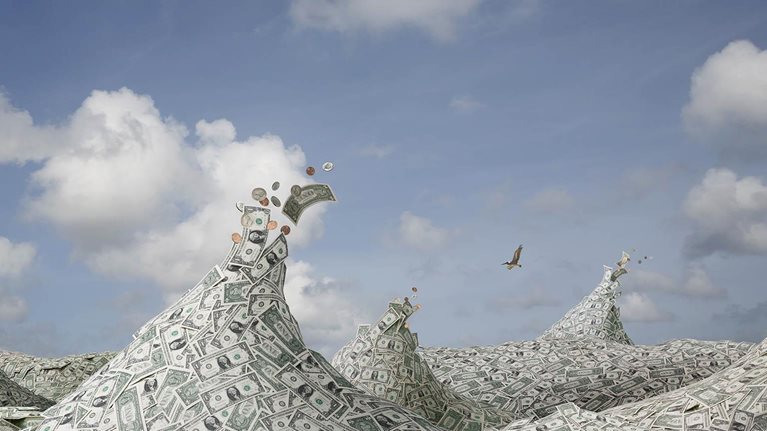After a series of record-breaking closes for US stocks and the prospect that lower corporate tax rates might continue to boost markets, investors had plenty to be excited about as 2017 drew to a close. But the run-up has also spurred growing concerns of a bubble in overpriced shares. At the time of this writing, the S&P 500 index’s one-year-forward price-earnings (PE) ratio stood at 18.6,1 higher than in the majority of years over the past five decades.
Yet it bears remembering that the headline number was misleading during the dot-com bubble around the turn of the century. And it may be so again. By digging deeper into what is behind that PE ratio and putting it into a context that includes the real economy, a picture of market value begins to emerge that doesn’t seem so extreme. Executives should focus on their companies’ and industries’ value, not markets as a whole. That said, additional perspective can help investors and strategic planners alike make better decisions.
Carrying weight
The S&P 500 is a value-weighted index, meaning that each company’s contribution to the index is not equal, but a reflection of its individual value. While in most years unusually high- or low-value companies will cancel out any distortion to the index overall, that isn’t always the case. In 1999, for example, a small number of mega-capitalization (megacap) stocks2 with very high PE ratios distorted the index. Removing those companies led to a PE ratio for the rest of the index that was well within normal bands. Something similar happened decades earlier. In 1972, a high-market-capitalization company like Kodak traded at 37 times its forward earnings and Xerox traded at 39 times.
We find the same situation today. Four megacap companies—Amazon, Facebook, Google (Alphabet), and Microsoft—together valued at more than $2 trillion, account for 10 percent of the index and, as a group, trade at a PE ratio of 29.3 Excess cash among the remainder accounts for another $1.2 trillion. (The S&P 500’s total market capitalization at the time of this writing in December was $23.4 trillion.) Excess cash distorts the index because it generates very little in earnings, leading to an implied high PE multiple.4 This is the case with the unusually large levels of cash held by a number of companies today. Removing the four companies mentioned above from the calculation and adjusting for the excess cash that companies hold as they await changes to tax laws before repatriating foreign profits reduces the current PE ratio to 16.9 (Exhibit 1). This is much closer to the range typical in “normal” economic times such as the mid-1960s, the late 1980s and early 1990s, and the years 2003 and 2004, when the US economy was growing and inflation was under control.

A real test
It is useful to put that number into context by relating it to the real economy.5 A company’s value and the market as a whole (as well as the PE ratio) are related to its cash-flow generation and its cost of capital. Cash-flow generation, in turn, depends on profit growth and return on capital. Using a discounted cash-flow model, we can reverse engineer the S&P 500’s PE ratio to see what future performance would be required to justify that PE ratio. A 16.9 PE ratio is consistent with a long-term profit growth rate of about 4.5 percent.6 Subtracting about 2.0 percent for expected inflation leads to a long-term real profit growth of about 2.5 percent. Profit growth is often compared to growth in GDP. That profit growth would be slightly over the 2.3 percent average annual GDP growth over the past 20 years, but below the 50 year rate of 2.8 percent. As for GDP forecasts, some analysts believe that the United States is stuck in a slow-growth environment of less than 2.0 percent real growth, while others believe that potential growth is closer to 2.5 to 3.0 percent.
Would you like to learn more about our Strategy & Corporate Finance Practice?
Care should be taken in comparing profit growth to GDP growth. On the one hand, corporate profits have been growing faster than US GDP and are near all-time highs, relative to GDP. These profit increases have occurred partly because of higher earnings from outside the United States and partly because of a shift in the economy toward higher-profit industries such as technology, pharmaceuticals, and medical devices. For example, the share of profits earned by high PE industries, including technology, pharmaceuticals, and medical devices, increased from 13 percent in 1989 to 32 percent in 2014.7 On the other hand, the share of profits from low PE industries, including automotive, mining, oil, chemicals, paper, and utilities, has declined from 52 to 26 percent during the same period.
Furthermore, some industrial companies, particularly those that provide critical components to other companies, have been able to increase their profit margins. Whether or not profit growth will keep up with GDP growth or slow is subject to debate. Another factor to consider is how the substantial reduction in corporate taxes as part of the US tax-reform effort plays out. Lower taxes could lead to a one-time increase in corporate profits or be eroded by competition, in which case savings would be mostly passed on to customers.
Overly sensitive?
The PE ratio is very sensitive to small changes in assumptions about future growth and the cost of equity (Exhibit 2). For example, a 16.9 PE is equivalent to a lower cost of equity of 8.5 percent and a lower nominal growth rate of 3.5 percent, compared to the base case presented above. Our earlier research explained that the cost of equity had not decreased with central bank policies of quantitative easing that produced unusually low interest rates.8 Others have argued that low rates are here to stay for a very long time and that the cost of equity should be lower.

The margin of error in interpreting PE ratios is quite large. In general, a half percentage point change in the cost of equity changes the PE ratio by a whopping two times, or about a 10 percent change in the index (about 260 points at the recent index value of 2,600). Similarly, a half percentage point change in the projected growth rate changes the PE ratio and value by between 5 and 10 percent.

The long and the short of stock-market volatility
This high level of sensitivity means that investors and executives shouldn’t read much into value fluctuations of 10 percent or even 20 percent. While a deep recession will undoubtedly reduce share prices for a period of time, what matters for long-term investors is the long-term trend in corporate profits and returns on capital.
For executives, it bears repeating that there isn’t much evidence that the cost of equity has declined significantly, despite low interest rates, so companies probably shouldn’t lower their required rates of return for investments. Furthermore, executives should focus on the value of their company and industry, not the market as a whole. They should also not put much weight on stock-market volatility, which will always be present and should not influence strategy.


